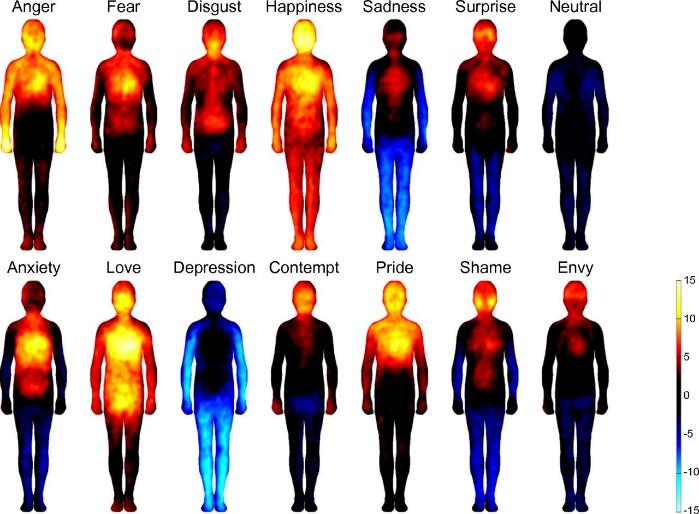Irene Pellicer Royo – neuro.motion.es
The approach to the emotional dimension from the body and movement arises from the emotional education proposal of the Professor of Psychopedagogical Orientation at the University of Barcelona, Rafael Bisquerra (2000), who affirms that the learning that is retained and endures in time are those linked to an emotion and this occurs more easily when these learnings are experiential.
Today the body must have a privileged place when learning how to manage the emotional world. This opportunity cannot be avoided, since they are powerful tools both to achieve better results in the sphere of sports performance, and to increase well-being and enjoyment of the motor experience in the sphere of leisure.
The person feels, in fact they cannot avoid feeling (Conangla and Soler, 2003), and it is precisely in the body where this emotional experience takes shape. This is clearly reflected in a study carried out by Aalto University in Finland (Nummenmaa, Glerean, Hari, & Hietanen, 2013), which was able to show how the emotional experience is reflected in the body. In this, attention is paid, mainly, to the variable of body temperature and it is appreciated how each emotion is expressed in a specific area of the body. Another fact to highlight is that it was possible to conclude that the emotional experience in people is universal, because the experience is very similar regardless of the variables: sex and origin of the people.

Figure 1. Body map of emotions (L. Nummenmaa, E. Glerean, R. Hari, J. K. Hietanen, 2013).
The expression of the emotional experience in the body does not remain in the variable of body temperature, it goes much further, since it affects the whole body: it increases or decreases the heart and respiratory rate, modifies muscle and arterial tension and changes brain chemistry.
In fact, when an emotion is felt, it initially reaches a specific area of the brain, the amygdala. Later, it will reach the prefrontal cortex, which is the area of the brain that allows us to understand the emotional experience. As soon as the emotion reaches the amygdala (thanks to the hypothalamus, which is the one that prepares and allows the body to act) the body reaction begins (Casafont, 2014). Depending on the specific emotion that is experienced, the brain will release a series of neurotransmitters or others.
Figure 2. Image of the brain showing the amygdala, prefrontal cortex and hypothalamus (Eric R. Kandel, 2019)
The relevance of this information when talking about motor action is that physical activity stimulates the release of neurotransmitters with effects that are more than beneficial for our health. On the one hand, we have endorphins, known as the hormone of happiness; serotonin, responsible for calm, patience and self-control; dopamine, related to motivation; norepinephrine, which enhances attention and perception, and oxytocin, popularized as the hug hormone (Ibarrola, 2013; Mora, 2010; Bisquerra, 2009 and Ratey, 2008).
When talking about the change in neuronal chemistry thanks to physical activity, we must also refer to glucocorticoids, one of the best known being cortisol. The segregation of these is related to stressful situations. What is relevant here is that physical activity is capable of slowing down the release of these substances, thus appeasing all the adverse reactions that stress generates in the body. In fact, authors such as Francisco Mora (2010) go so far as to affirm that physical activity is a true antidote to this task.
It should also be noted that glucocorticoids predispose the body for survival. If you are prepared to survive, you do not have a mind that is neither flexible nor open to the actions to be carried out. However, when one is able to lubricate the brain with endorphins, serotonin, etc., the emotional predisposition is much more adequate, since it leads us to calmer brains and, therefore, more plastic, to find diverse possibilities and to be able to develop any task type. The importance of being able to choose the brain chemistry you want is a privilege that can be accessed.
As for how to regulate emotions from the body, there are two ways: energy-emotional release activities and activities of stillness. The first refer to mobilizing the body: running, jumping, dancing, etc. The latter refer to contemplative activities: meditation, breathing, sunbathing, painting, etc. Depending on the person and the moment, it will be more appropriate to carry out one or the other. The important thing is to have a wide range of possibilities to, when necessary, be able to implement any of them.
The two pathways of emotional regulation that are exposed cause the body to relax and as soon as this relaxes, the brain receives the message that it can rest. An area of special interest in this task is the jaw (when it is relaxed, the lips are separated and the teeth are not clenched). The second key point is the tongue (when it rests on the lower jaw is when distension occurs). When the jaw and tongue are relaxed, it is when you enjoy the aforementioned brain relaxation. In fact, the role of the jaw is so relevant that Bud Winter (1981), considered one of the best speed coaches in the world, told his sprinters that he wanted to see them run with their lower lip loose, wobbling.
When it comes to attending and caring for the emotional world, the relationship between emotion and body is intimate; An adequate brain chemistry will be the one that allows the body and the brain to unfold all their potentialities. This makes the body-emotional connection an inexcusable aspect when choosing the learning for life to address.